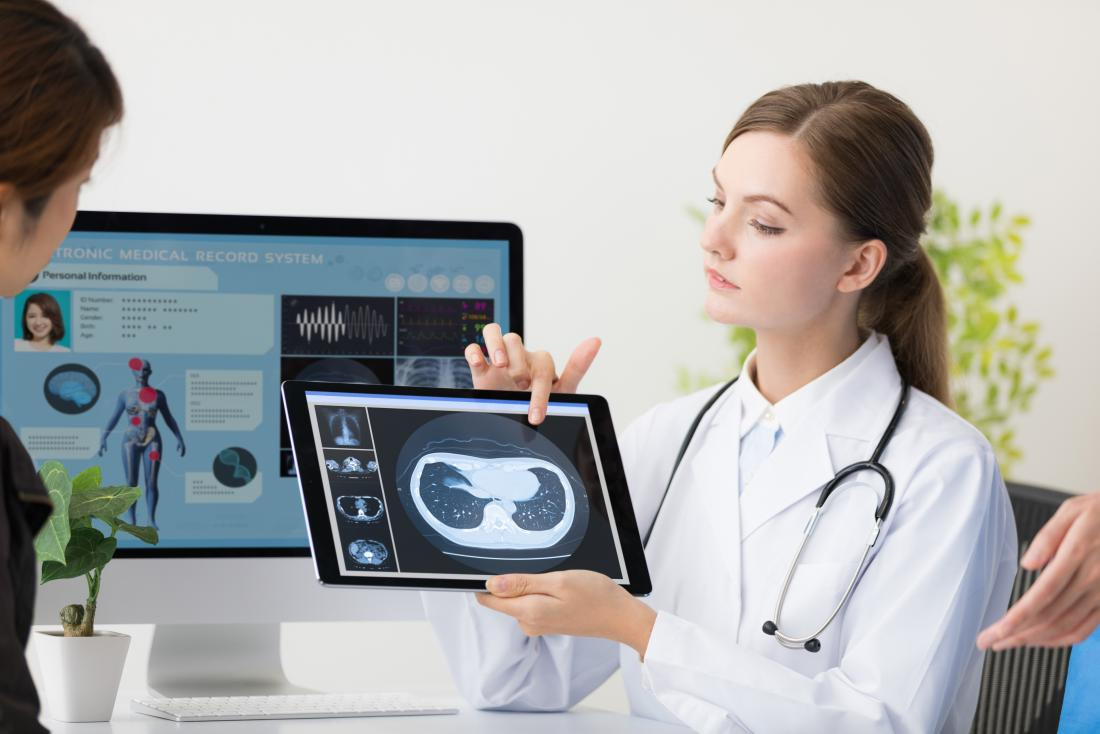Many people find medical imaging terminology confusing, especially when it comes to scans like CAT scans and CT scans. You might wonder, Is Cat Scan And Ct Scan The Same? The answer is yes. CAT scan and CT scan are simply different names for the same diagnostic imaging procedure. CAT stands for Computerized Axial Tomography, while CT represents Computed Tomography. Both terms refer to a sophisticated X-ray technique that creates detailed cross-sectional images of the inside of your body.
 A patient undergoing a CT scan, also known as a CAT scan, in a medical facility. CT scans are valuable diagnostic tools despite carrying minimal radiation risks.
A patient undergoing a CT scan, also known as a CAT scan, in a medical facility. CT scans are valuable diagnostic tools despite carrying minimal radiation risks.
Delving Deeper: CAT Scan vs. CT Scan – It’s the Same Thing!
To clarify, there is absolutely no difference between a CAT scan and a CT scan. The acronym “CAT scan” is older, reflecting the original name of the technology, Computerized Axial Tomography. As technology evolved, the “Axial” part was dropped as scans became more versatile, capturing data in various planes, not just axially. However, both CAT scan and CT scan refer to the same procedure using X-rays and computer processing to generate detailed images. Think of it like “soda” versus “pop” – different regional terms for the same fizzy drink.
Why Doctors Use CT Scans (or CAT Scans)
Doctors recommend CT scans for a multitude of reasons. These scans are incredibly valuable in diagnosing a wide range of conditions because they provide detailed images of soft tissues, blood vessels, and bones. A CT scan can help:
- Detect and monitor diseases: From cancer to heart disease and infections, CT scans can identify abnormalities and track their progression.
- Diagnose muscle and bone disorders: Conditions like fractures, tumors, and osteoporosis can be clearly visualized.
- Pinpoint internal injuries and bleeding: In emergency situations, CT scans are crucial for quickly identifying internal trauma.
- Guide medical procedures: CT scans assist in biopsies, radiation therapy, and surgery by providing precise anatomical information.
In many cases, a CT scan is the most effective way to visualize internal structures and arrive at an accurate diagnosis, guiding appropriate treatment plans.
Understanding the Risks Associated with CT Scans
Like X-rays, CT scans utilize ionizing radiation to create images. This radiation exposure is a primary concern for many patients. It’s important to understand the risks in perspective:
- Low Radiation Dose: Modern CT technology uses the lowest radiation dose necessary to produce clear images.
- Minimal Cancer Risk: The risk of developing cancer from a CT scan is considered very low. According to the NHS, it’s estimated to be less than 1 in 2,000. This risk is comparable to the natural background radiation we are exposed to daily over several months to years.
- Benefits Outweigh Risks: Doctors only recommend CT scans when the medical benefits of diagnosis significantly outweigh the small potential risk from radiation. The information gained from a CT scan can be crucial for timely and effective treatment of serious conditions.
While the radiation risk is minimal, it’s always a valid concern, especially for certain groups.
Special Considerations: Pregnancy, Breastfeeding, and Claustrophobia
It’s crucial to inform your doctor if any of the following apply to you:
- Pregnancy: If you are pregnant or suspect you might be, tell your doctor. While the radiation from a single CT scan is unlikely to harm a fetus, CT scans are generally avoided during pregnancy unless absolutely necessary and the benefits clearly outweigh the potential risks. Alternative imaging methods like ultrasound or MRI might be considered.
- Breastfeeding: If you are breastfeeding and require a CT scan with intravenous contrast dye, you may need to temporarily pause breastfeeding for around 24 hours after the scan, as the dye could pass into breast milk. Discuss this with your doctor for specific guidance.
- Claustrophobia: The CT scan machine can feel enclosed, potentially triggering claustrophobia. If you are claustrophobic, inform your doctor or radiographer beforehand. Medication can be provided to help you relax during the scan.
Conclusion: CT Scans (CAT Scans) are Safe and Valuable
In summary, whether you hear it called a CAT scan or a CT scan, know that it’s the same valuable diagnostic tool. While CT scans do involve a small amount of radiation, the risk is low, and the benefits in diagnosing and managing medical conditions are substantial. When medically necessary, a CT scan is a safe and powerful way to gain crucial insights into your health. Always discuss any concerns you have with your doctor to make informed decisions about your healthcare.

